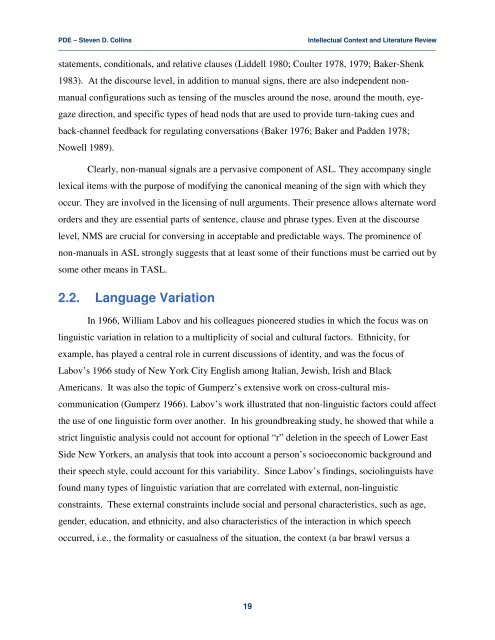Adverbial Morphemes in Tactile ASL - Gallaudet University
Adverbial Morphemes in Tactile ASL - Gallaudet University
Adverbial Morphemes in Tactile ASL - Gallaudet University
You also want an ePaper? Increase the reach of your titles
YUMPU automatically turns print PDFs into web optimized ePapers that Google loves.
PDE – Steven D. Coll<strong>in</strong>s<br />
Intellectual Context and Literature Review<br />
_________________________________________________________________________________________________________<br />
statements, conditionals, and relative clauses (Liddell 1980; Coulter 1978, 1979; Baker-Shenk<br />
1983). At the discourse level, <strong>in</strong> addition to manual signs, there are also <strong>in</strong>dependent nonmanual<br />
configurations such as tens<strong>in</strong>g of the muscles around the nose, around the mouth, eyegaze<br />
direction, and specific types of head nods that are used to provide turn-tak<strong>in</strong>g cues and<br />
back-channel feedback for regulat<strong>in</strong>g conversations (Baker 1976; Baker and Padden 1978;<br />
Nowell 1989).<br />
Clearly, non-manual signals are a pervasive component of <strong>ASL</strong>. They accompany s<strong>in</strong>gle<br />
lexical items with the purpose of modify<strong>in</strong>g the canonical mean<strong>in</strong>g of the sign with which they<br />
occur. They are <strong>in</strong>volved <strong>in</strong> the licens<strong>in</strong>g of null arguments. Their presence allows alternate word<br />
orders and they are essential parts of sentence, clause and phrase types. Even at the discourse<br />
level, NMS are crucial for convers<strong>in</strong>g <strong>in</strong> acceptable and predictable ways. The prom<strong>in</strong>ence of<br />
non-manuals <strong>in</strong> <strong>ASL</strong> strongly suggests that at least some of their functions must be carried out by<br />
some other means <strong>in</strong> T<strong>ASL</strong>.<br />
2.2. Language Variation<br />
In 1966, William Labov and his colleagues pioneered studies <strong>in</strong> which the focus was on<br />
l<strong>in</strong>guistic variation <strong>in</strong> relation to a multiplicity of social and cultural factors. Ethnicity, for<br />
example, has played a central role <strong>in</strong> current discussions of identity, and was the focus of<br />
Labov’s 1966 study of New York City English among Italian, Jewish, Irish and Black<br />
Americans. It was also the topic of Gumperz’s extensive work on cross-cultural miscommunication<br />
(Gumperz 1966). Labov’s work illustrated that non-l<strong>in</strong>guistic factors could affect<br />
the use of one l<strong>in</strong>guistic form over another. In his groundbreak<strong>in</strong>g study, he showed that while a<br />
strict l<strong>in</strong>guistic analysis could not account for optional “r” deletion <strong>in</strong> the speech of Lower East<br />
Side New Yorkers, an analysis that took <strong>in</strong>to account a person’s socioeconomic background and<br />
their speech style, could account for this variability. S<strong>in</strong>ce Labov’s f<strong>in</strong>d<strong>in</strong>gs, sociol<strong>in</strong>guists have<br />
found many types of l<strong>in</strong>guistic variation that are correlated with external, non-l<strong>in</strong>guistic<br />
constra<strong>in</strong>ts. These external constra<strong>in</strong>ts <strong>in</strong>clude social and personal characteristics, such as age,<br />
gender, education, and ethnicity, and also characteristics of the <strong>in</strong>teraction <strong>in</strong> which speech<br />
occurred, i.e., the formality or casualness of the situation, the context (a bar brawl versus a<br />
19
















